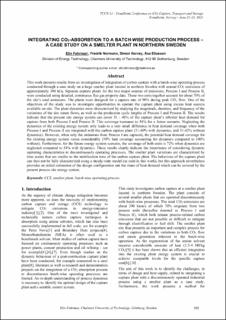| dc.contributor.author | Fahrman, Elin | |
| dc.contributor.author | Normann, Fredrik | |
| dc.contributor.author | Harvey, Simon | |
| dc.contributor.author | Eliasson, Åsa | |
| dc.date.accessioned | 2021-09-23T07:55:12Z | |
| dc.date.available | 2021-09-23T07:55:12Z | |
| dc.date.issued | 2021 | |
| dc.identifier.isbn | 978-82-536-1714-5 | |
| dc.identifier.issn | 2387-4295 | |
| dc.identifier.uri | https://hdl.handle.net/11250/2780676 | |
| dc.description.abstract | This work presents results from an investigation of integration of carbon capture with a batch-wise operating process conducted through a case study on a large smelter plant located in northern Sweden with annual CO2 emissions of approximately 300 kt/a. Separate capture plants for the two major sources of emissions, Process I and Process II, were conducted using detailed, continuous flue gas property data. These two units together account for about 70% of the site’s total emissions. The plants were designed for a capture rate of 90% during peak CO2 flow. One of the objectives of the study was to investigate opportunities to operate the capture plant using excess heat sources available on site. The plant dynamics were characterized by studying the magnitude, duration, and frequency of the variations of the site steam flows, as well as the production cycle lengths of Process I and Process II. The results indicate that the present site energy system can cover 31 - 40% of the capture plant’s reboiler heat demand for capture from both Process I and Process II. This coverage increases to 54% for a future scenario. Neglecting the dynamics of the existing energy system only leads to a very small difference in heat demand coverage when both Process I and Process II are integrated with the carbon capture plant (31-40% with dynamics, and 31-42% without dynamics). However, when only the emissions from Process I are captured, the potential heat demand coverage for the existing energy system varies considerably (50% heat coverage accounting for dynamics compared to 100% without). Furthermore, for the future energy system scenario, the coverage of both units is 72% when dynamics are neglected compared to 54% with dynamics. These results clearly indicate the importance of considering dynamic operating characteristics in discontinuously operating processes. The smelter plant variations are characterized by time scales that are similar to the stabilization time of the carbon capture plant. The behaviour of the capture plant can thus not be fully characterized using a steady-state model (as used in this work), but this approach nevertheless provides an initial estimation of the design configuration and the share of heat demand which can be covered by the present process site energy system. | en_US |
| dc.language.iso | eng | en_US |
| dc.publisher | SINTEF Academic Press | en_US |
| dc.relation.ispartof | TCCS–11. CO2 Capture, Transport and Storage. Trondheim 22nd–23rd June 2021
Short Papers from the 11th International Trondheim CCS Conference | |
| dc.relation.ispartofseries | SINTEF Proceedings;7 | |
| dc.rights | CC BY 4.0 | * |
| dc.rights.uri | https://creativecommons.org/licenses/by/4.0/ | * |
| dc.subject | CCS | en_US |
| dc.subject | Smelter plant | en_US |
| dc.subject | Batch wise operating process | en_US |
| dc.title | Integrating Co2-Absorbtion to a Batch-Wise Production Process – A Case Study on a Smelter Plant in Northern Sweden | en_US |
| dc.type | Chapter | en_US |
| dc.type | Peer reviewed | en_US |
| dc.type | Conference object | en_US |
| dc.description.version | publishedVersion | en_US |
| dc.rights.holder | © 2021 The Authors. Published by SINTEF Academic Press. | en_US |
| dc.subject.nsi | VDP::Teknologi: 500 | en_US |

